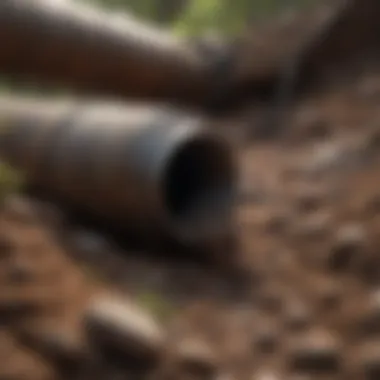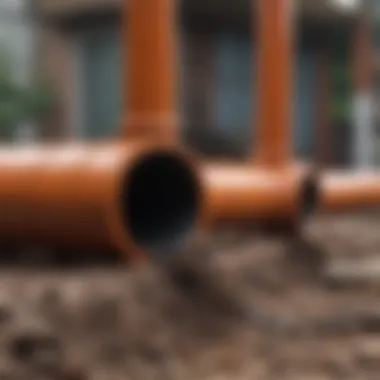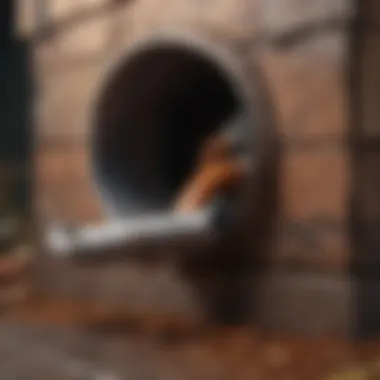Exploring the Ramifications of a Clogged Pipe: Solutions Unveiled


Have you ever found yourself facing the frustrating issue of a choked pipe at home? The impediment caused by a blockage in your plumbing system can lead to a multitude of challenges and concerns that require immediate attention. In this article, we will delve deep into the complexities associated with a choked pipe, examining its far-reaching implications on water flow, maintenance procedures, and the potential risks it poses to your household. By dissecting the root causes of pipe blockages and presenting effective solutions to tackle this common plumbing predicament, we aim to equip you with a comprehensive understanding of how to navigate through this plumbing conundrum successfully.
Understanding the Challenges of a Choked Pipe
From hindering the smooth flow of water to triggering maintenance hazards, a choked pipe can wreak havoc on your living space. Imagine the inconvenience of a clogged kitchen sink or a blocked bathroom drain, disrupting your daily routines and creating an unsanitary environment within your home. Such blockages not only impede the efficient functioning of your plumbing system but also give rise to potential leakages, water damage, and even health hazards if not addressed in a timely manner.
Root Causes of Pipe Blockages
To effectively tackle a choked pipe, it is crucial to identify the primary factors contributing to its obstruction. Common culprits include the accumulation of debris like hair, grease, soap scum, and food particles within the pipes, gradually forming blockages that restrict the flow of water. Additionally, mineral deposits, tree root intrusions, and structural defects in the plumbing network can exacerbate the issue, necessitating prompt remedial action to mitigate the blockage and restore proper functionality.
Solutions to Overcoming Pipe Blockages
When faced with a choked pipe, there are several strategies you can employ to alleviate the blockage and restore your plumbing system to optimal working condition. Utilizing tools such as plumbing snakes, drain augers, and environmentally-friendly drain cleaners can help dislodge obstructions and clear the pathway for unrestricted water flow. Furthermore, regular maintenance practices such as periodic pipe inspections, drain cleaning, and implementing hair catchers or grease traps can prevent future blockages, ensuring the long-term health and efficiency of your plumbing infrastructure.
Inspiring Homes
- Showcase of diverse properties worldwide, from extravagant mansions to charming cottages
- Explore innovative architectural designs and breathtaking buildings
Thank you for your attention and get ready to bid farewell to choked pipes with our comprehensive guide on understanding the implications and solutions associated with this common plumbing predicament.
Introduction
In the realm of plumbing intricacies and maintenance, understanding the phenomenon of a choked pipe is indispensable. This article delves deep into the challenges and consequences posed by a blocked pipe, shedding light on its implications on water flow, maintenance exigencies, and potential hazards that can ensue from such an issue. By dissecting the root causes of pipe blockages, we aim to present readers with a nuanced perspective that transcends the surface-level manifestations of this common plumbing conundrum.
As we navigate through this comprehensive guide on choked pipes, it is crucial to unravel the intricate web of factors that contribute to this vexing issue. From the insidious accumulation of debris within the pipelines to the relentless assault of corrosion and rust, and even the infiltration of tree roots that silently wreak havoc underground, the causes of pipe blockages are as diverse as they are detrimental.
The stakes are higher than mere inconvenience; a choked pipe can pave the way for a myriad of unwelcome consequences. Reduced water flow not only disrupts the daily routine but can also hint at more sinister problems bubbling beneath the surface. The potential threat of bursting pipes looms large, entailing costly repairs and extensive water damage. Additionally, compromised pipes harbor health and safety risks, creating a breeding ground for contaminants and pathogens that can seep into the water supply.
In the intricate tapestry of drainage systems, the impact of a choked pipe reverberates far beyond a mere blockage. Backflow issues disrupt the delicate equilibrium of wastewater management, leading to overflows and contamination. Foul odors emanating from obstructed pipes not only assault the olfactory senses but also serve as a warning sign of underlying plumbing maladies that demand immediate attention.
In this introductory section, we lay the foundation for a profound exploration of choked pipes, setting the stage for an in-depth analysis of the signs, preventive measures, and solutions that are instrumental in mitigating this pervasive plumbing predicament.
Understanding the Choked Pipe Phenomenon


In this section of the article, we will delve deep into the crucial topic of understanding the choked pipe phenomenon. Recognizing the reasons behind pipe blockages is paramount in comprehending the complexities associated with maintenance, water flow, and potential risks. By grasping the root causes of pipe obstructions, individuals can effectively address and mitigate these issues, ensuring the smooth operation of drainage systems and averting potential hazards.
Causes of Pipe Blockages
Accumulation of Debris
The buildup of debris within pipes is a critical factor contributing to blockages. Debris such as dirt, grease, and foreign objects can constrict the passage of water, leading to inefficiencies in the plumbing system. Understanding the detrimental impact of debris accumulation is essential in combating pipe clogs and ensuring optimal water flow.
Corrosion and Rust
Corrosion and rust can weaken the structural integrity of pipes, making them prone to blockages and leaks. The corrosive nature of these elements erodes the inner lining of pipes, creating rough surfaces that trap debris and impede water flow. Addressing corrosion and rust issues promptly is crucial in maintaining the longevity and functionality of plumbing systems.
Tree Root Infiltration
Tree roots infiltrating underground pipes pose a significant threat to their integrity. As roots grow and expand, they can penetrate pipe walls, causing blockages and structural damage. Understanding the invasive nature of tree roots and implementing preventive measures is vital in preserving the integrity of drainage systems.
Consequences of a Choked Pipe
Reduced Water Flow
A choked pipe significantly restricts the flow of water, leading to diminished water pressure and decreased efficiency in household activities. Recognizing the implications of reduced water flow underscores the importance of timely intervention to restore the plumbing system's functionality and performance.
Potential Bursting
The excessive pressure exerted on pipes due to blockages increases the risk of bursting, resulting in costly repairs and water damage. Understanding the potential for pipes to burst emphasizes the necessity of proactive maintenance and regular inspections to prevent catastrophic failures.
Health and Safety Risks
Choked pipes not only impede water flow but also pose health and safety risks to occupants. Stagnant water within blocked pipes can harbor harmful bacteria and pathogens, compromising the quality of water and endangering the well-being of individuals. Recognizing the health and safety hazards associated with choked pipes underscores the urgency of addressing blockages promptly to safeguard the health of residents.
Impact on Drainage Systems
Backflow Issues


Blockages in pipes can lead to backflow, where wastewater reverses its flow direction and enters living spaces. Backflow poses sanitation concerns and can contaminate clean water sources, jeopardizing public health. Understanding the implications of backflow emphasizes the necessity of implementing backflow prevention measures to protect drainage systems and ensure water purity.
Foul Odors
Blocked pipes often emit foul odors due to the accumulation of waste material and stagnant water. These unpleasant odors not only indicate a plumbing issue but can also create discomfort and health risks for occupants. Addressing foul odors from choked pipes requires thorough cleaning and maintenance to eliminate debris buildup and restore a hygienic environment.
Signs of a Choked Pipe
Signs of a Choked Pipe play a crucial role in understanding the underlying issues within a plumbing system. Detecting early indicators can prevent more severe problems like burst pipes or sewage backups. Slow Drainage is one common sign that a pipe is becoming blocked. As water struggles to flow through the pipe, it leads to sluggish draining in sinks, showers, or toilets. This can indicate a buildup of debris or a partial blockage within the pipe. Addressing Slow Drainage promptly can help avoid more significant plumbing issues. Additionally, Gurgling Sounds coming from drains can signify trapped air due to blockages, causing disruptions in the water flow. Ignoring these sounds could result in complete pipe blockages if left untreated. Furthermore, Foul Smells emanating from drains indicate decomposing organic matter accumulating in the pipes, leading to unpleasant odors. Recognizing these odors early on can prompt homeowners to take action before the situation worsens. Understanding these Signs of a Choked Pipe is essential in maintaining a healthy plumbing system and preventing costly repairs.
Slow Drainage
Slow Drainage is a noticeable sign of a potentially blocked pipe, indicating a restriction in water flow. This commonly manifests as water taking longer than usual to empty from sinks, showers, or tubs. The gradual draining may be caused by a buildup of debris, grease, or mineral deposits inside the pipes. Regular maintenance can help prevent Slow Drainage by clearing out these obstructions. If left unattended, Slow Drainage can lead to complete blockages, necessitating professional intervention. Therefore, it is crucial to address Slow Drainage promptly to maintain the efficiency of the plumbing system.
Gurgling Sounds
Gurgling Sounds coming from drains are a clear indication that something is amiss within the plumbing system. These noises occur when air is trapped in the pipes due to blockages, hindering the smooth flow of water. Ignoring Gurgling Sounds can result in air pressure buildup, leading to potential pipe bursts or leaks. Addressing this issue early on by investigating the source of the blockage can prevent more significant plumbing problems. Regular inspections and timely interventions can help eliminate Gurgling Sounds and ensure the proper functioning of the drainage system.
Foul Smells
Foul Smells emanating from drains are a distressing sign of pipe blockages, indicating the presence of decaying organic matter. These odors are not only unpleasant but also pose health risks to occupants. Identifying and resolving the source of Foul Smells is crucial in maintaining a hygienic living environment. Preventive measures such as proper waste disposal and regular cleaning can help mitigate Foul Smells and promote a healthy plumbing system. Addressing Foul Smells promptly can prevent further deterioration of the pipes and ensure a pleasant indoor atmosphere.
Preventive Measures
When it comes to tackling the specter of a choked pipe, preventive measures stand as stalwart defenders against the impending plumbing calamity. In this article shedding light on navigating a choked pipe, understanding the implications and solutions, the section on preventive measures takes center stage in fortifying one's drainage systems. By emphasizing proactive strategies to avert pipe blockages, this segment serves as a vital cog in the machinery of maintaining seamless water flow and safeguarding against potential hazards.
Regular Maintenance
Delving deeper into the realm of preventive measures, regular maintenance emerges as a linchpin in the quest for unimpeded water circulation. Scheduled inspections, cleaning routines, and systematic checks can unearth burgeoning issues within the piping infrastructure, allowing for timely interventions to thwart blockages. By adhering to a regimen of regular maintenance, individuals can preemptively address minor concerns before they escalate into full-blown pipe obstructions, thereby ensuring the perpetual functionality of their drainage network.
Avoiding Grease Buildup
One of the primary culprits behind pipe clogs, grease buildup insidiously infiltrates drainage systems, congealing over time and impeding the free passage of water. In the discourse of preventive measures against choked pipes, steering clear of pouring fatty substances down the drain emerges as a cardinal rule. By adopting prudent habits such as proper disposal of cooking oils and grease residues, individuals can significantly diminish the likelihood of grease-induced blockages, thus upholding the efficiency of their plumbing infrastructure.


Proper Waste Disposal
In the tapestry of preventive measures delineated to combat the choking of pipes, proper waste disposal emerges as a critical thread. Disposing of waste materials, non-biodegradable items, and foreign objects in a responsible manner holds the key to preserving the unobstructed flow of water through drainage conduits. By conscientiously adhering to waste disposal guidelines and refraining from indiscriminate dumping of debris, individuals contribute to the longevity and functionality of their piping systems, averting potential blockages and mitigating maintenance challenges.
Dealing with a Choked Pipe
In the realm of plumbing challenges, dealing with a choked pipe stands out as a critical topic that demands attention and prompt resolution. The implications of a choked pipe can go beyond mere inconvenience, potentially leading to severe consequences if left unaddressed. As such, understanding how to effectively tackle a choked pipe becomes paramount in ensuring the smooth functioning of drainage systems and averting potential hazards. By exploring the DIY methods and professional interventions available for dealing with a choked pipe, individuals can equip themselves with the necessary knowledge to address this common issue efficiently and effectively.
DIY Methods
Using a Plunger
When confronting a choked pipe, one of the most commonly used DIY methods is employing a plunger. This tool exerts pressure to dislodge blockages within the pipe, helping to restore proper water flow. The key characteristic of using a plunger lies in its simplicity and accessibility, making it a go-to choice for addressing minor pipe blockages. Although using a plunger can be highly effective in clearing clogs, it is essential to note its limitations, particularly when dealing with more stubborn or complex blockages. Despite its straightforward approach, a plunger remains a valuable tool in the DIY arsenal for combating choked pipes.
Hot Water Flush
Another DIY method for addressing a choked pipe involves utilizing a hot water flush. This technique entails pouring hot water down the drain to dissolve grease, soap scum, and other debris that may be contributing to the blockage. The key characteristic of a hot water flush is its ability to break down organic matter within the pipe, facilitating the removal of obstructions and improving water flow. While a hot water flush can be a cost-effective and environmentally friendly solution, it may not effectively clear all types of blockages, particularly those caused by solid materials. Despite its efficacy in certain scenarios, a hot water flush is best suited for relatively mild pipe blockages.
Baking Soda and Vinegar
Utilizing a combination of baking soda and vinegar presents another DIY method for addressing a choked pipe. When these two substances react, they produce a foaming action that can help dislodge and dissolve blockages within the pipe. The key characteristic of using baking soda and vinegar lies in their natural and non-toxic properties, making them a safe option for clearing minor pipe obstructions. While this method can be effective for mild blockages, it may not always suffice for more stubborn or extensive clogs. Despite its gentle approach, baking soda and vinegar offer a chemical-free alternative for addressing choked pipes.
Professional Intervention
Hydro-jetting
For more persistent or challenging pipe blockages, professional intervention through hydro-jetting may be necessary. Hydro-jetting involves using high-pressure water streams to scour the interior of the pipe, dislodging stubborn debris and buildup. The key characteristic of hydro-jetting lies in its effectiveness in clearing even the most stubborn blockages, restoring optimal water flow within the pipe. While hydro-jetting can be a highly efficient solution, it requires specialized equipment and expertise, making it best suited for severe pipe obstructions that DIY methods may not effectively resolve. Despite its thorough cleaning capabilities, hydro-jetting should be undertaken by trained professionals to ensure safe and effective results.
Snaking
Another common professional intervention for dealing with choked pipes is snaking, wherein a plumber employs a flexible auger to navigate through the pipe and break apart the blockage. The key characteristic of snaking lies in its precision and versatility, allowing plumbers to target specific areas of the pipe experiencing blockages. While snaking is highly effective for removing blockages caused by solid materials or tree roots, it may not always address issues deeper within the pipe system. Despite its ability to tackle challenging obstructions, snaking remains a tried-and-true method for professional pipe cleaning, offering a targeted approach to resolving complex blockages.
Conclusion
In the intricate web of plumbing systems, the significance of understanding the implications and solutions related to a choked pipe cannot be overstated. As we unravel the complexities of this common predicament, we are confronted with a myriad of reasons why addressing this issue promptly is crucial. From the tangible consequences affecting water flow and potential hazards to the intangible aspects of maintenance and safety, a choked pipe has wide-reaching effects. By delving into the key points highlighted throughout this article, readers can grasp not only the technical aspects but also the practical implications of dealing with a choked pipe.
One of the primary benefits of acknowledging the importance of a comprehensive overview of a choked pipe lies in the preventive measures that can be implemented. By being equipped with the knowledge of potential causes, individuals can take proactive steps to avoid blockages and keep their plumbing systems running smoothly. Furthermore, understanding the consequences of neglecting a choked pipe underscores the necessity of regular maintenance and timely interventions.
When considering the various solutions provided in this guide, it becomes clear that each method serves a specific purpose in combating pipe blockages effectively. Whether opting for do-it-yourself remedies or seeking professional assistance, the array of options available caters to different needs and scenarios. By weighing the benefits and considerations of each approach, readers can make informed decisions on how best to address a choked pipe situation.
In essence, the conclusion of this article encapsulates the essence of navigating a choked pipe with a holistic view of the implications and solutions. By synthesizing the information presented throughout, readers are not only empowered to tackle this common plumbing issue with confidence but also gain a deeper appreciation for the intricacies of maintaining and safeguarding their drainage systems. The journey through understanding a choked pipe serves as a testimonial to the importance of proactive care and vigilance in ensuring the smooth operation of essential household infrastructures.



